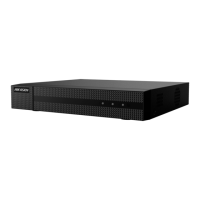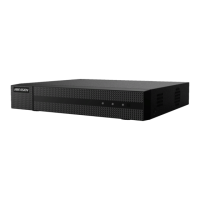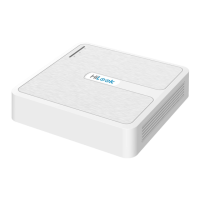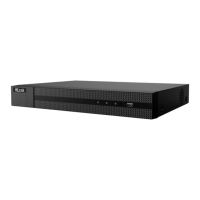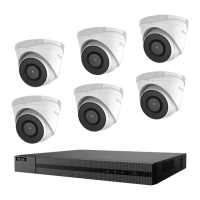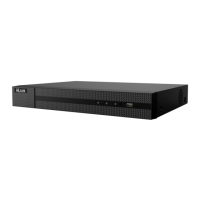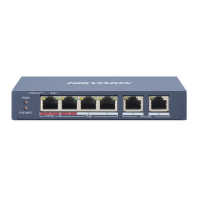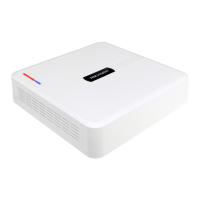
Do you have a question about the HIKVISION HWN-2104H-4P and is the answer not in the manual?
| Input bandwidth | 40 Mbit/s |
|---|---|
| Output bandwidth | 60 Mbit/s |
| Maximum resolution | 1920 x 1080 pixels |
| Video input channels | 4 channels |
| Supported resolutions | 1920x1080, 1280x1024, 1280x720, 1024x768 |
| Video formats supported | H.264, H.264+, H.265, H.265+ |
| Wi-Fi | No |
| HDD capacity | 0 GB |
| HDD interface | Serial ATA |
| Maximum storage capacity | 6 TB |
| Number of HDDs installed | 0 |
| Number of HDDs supported | 1 |
| Networking standards | IEEE 802.3af, IEEE 802.3at |
| USB 2.0 ports quantity | 2 |
| Ethernet LAN data rates | 10, 100 Mbit/s |
| Power over Ethernet (PoE) | Yes |
| Ethernet LAN (RJ-45) ports | 5 |
| Supported network protocols | TCP/IP, DHCP, Hik-Connect, DNS, DDNS, NTP, SADP, SMTP, UPnP |
| Output voltage | 48 V |
| Product color | White |
| Rack capacity | 1U |
| Operating temperature (T-T) | -10 - 55 °C |
| Operating relative humidity (H-H) | 10 - 90 % |
| Depth | 205 mm |
|---|---|
| Width | 200 mm |
| Height | 48 mm |
| Weight | 1000 g |
Details compliance with FCC rules for digital devices and interference.
States product compliance with European standards for EMC, LVD, and RoHS.
Provides essential advice before connecting and operating the device.
Outlines general connectivity and video format capabilities.
Details video output resolutions and live view display features.
Covers storage capacity, disk support, and group management.
Explains how to export video clips and manage backup devices.
Covers alarm linkage and exception handling for various events.
Describes the indicators and ports on the front panel of the NVR.
Explains how to use the IR remote control for NVR operations.
Details how to use a USB mouse for NVR control.
Explains the on-screen keyboard and input method functionalities.
Details the interfaces and ports located on the rear panel of the NVR.
Covers initial NVR startup, shutdown, and device activation procedures.
Guides through the setup wizard for initial NVR configuration.
Explains how to activate and add IP cameras to the NVR.
Provides an overview of the live view interface and its icons.
Details various functions and controls available in live view mode.
Explains how to customize live view display and output settings.
Describes how to reduce bandwidth requirements for remote viewing.
Covers the procedure for setting PTZ camera parameters.
Details how to customize and manage PTZ presets, patrols, and patterns.
Explains how to access and use the PTZ control panel.
Defines parameters affecting image quality, stream type, and resolution.
Explains how to set up automatic recording schedules.
Details how to set up motion detection parameters and actions.
Covers configuring recording triggered by alarm inputs.
Explains how to configure recording triggered by VCA events.
Describes how to manually start and stop recording.
Allows setting specific recording or capture schedules for holidays.
Ensures data safety by saving records on redundant HDD.
Enables grouping HDDs for specific recording and capture tasks.
Details methods to lock recording files or set HDD to read-only.
Covers instant, normal, smart, event, tag, system log, and external file playback.
Details frame-by-frame playback, thumbnails, fast view, digital zoom, and file management.
Explains quick export, normal video backup, event search backup, and clip backup.
Covers management of USB drives, HDDs, and eSATA devices for backup.
Configures motion detection areas, sensitivity, and alarm response.
Details handling actions for external sensor alarms.
Covers detection of video loss and associated alarm response actions.
Explains detection of video tampering and setting alarm responses.
Configures response actions for various system exceptions like HDD errors.
Details response actions like event hints, audio warnings, and email notifications.
Allows manual triggering or clearing of alarm outputs.
Configures face detection rules, sensitivity, and alarm actions.
Sets up rules for detecting objects crossing a virtual line.
Configures rules for detecting objects entering a pre-defined region.
Sets up detection for objects entering a defined virtual region.
Configures detection for objects exiting a defined virtual region.
Detects unattended objects left in a pre-defined region.
Detects objects removed from a pre-defined region.
Detects abnormal sound levels in the surveillance scene.
Detects changes in the surveillance environment.
Detects image blur caused by lens defocus.
Configures alarm for motion detection within the camera's field of view.
Searches for captured face pictures and related video files.
Analyzes and searches for suspicious behavior based on VCA detection.
Sets up basic network parameters like IP address and working mode.
Covers Hik-Connect, DDNS, NTP, SNMP, HTTPS, NAT, and Virtual Host settings.
Provides tools to check network status, delay, packet loss, and statistics.
Guides on initializing newly installed hard disk drives.
Covers adding and configuring NAS or IP SAN disks as network HDDs.
Explains how to configure and manage external eSATA devices.
Details how to manage multiple HDDs in groups for recording.
Allows allocating specific storage quotas for each camera.
Describes cloning HDD data to an eSATA disk for backup.
Covers methods to check the status of installed HDDs.
Explains S.M.A.R.T. and Bad Sector Detection for HDD health.
Sets up alarms for HDD errors like Uninitialized or Abnormal status.
Allows customization of on-screen display elements like date/time and name.
Enables setting privacy mask zones to obscure specific surveillance areas.
Covers adjusting image parameters like brightness, contrast, and mirror settings.
Provides access to device information like model, firmware, and status.
Covers searching, viewing, and exporting system operation and alarm logs.
Facilitates backup and transfer of IP camera configuration data.
Enables backup and restoration of NVR configuration settings.
Details firmware upgrades via local backup devices or FTP server.
Explains how to restore NVR parameters to factory defaults.
Covers settings for RS-232 serial port communication.
Allows configuration of language, output standards, and time settings.
Enables automatic or manual adjustment for Daylight Saving Time.
Covers device name, auto logout, and menu output mode settings.
Details adding, deleting, editing, and managing user permissions.
Provides definitions for technical terms used in the manual.
Offers solutions for common issues like no display or HDD errors.


